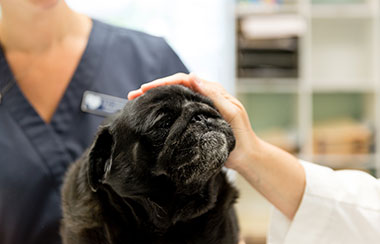
Recommendations For Senior Dogs
Dogs older than seven years of age are considered senior pets. Senior dogs are in the stage of life in which the aging process is affecting every organ. Some organs “wear out” faster than others, so certain observations are especially important to make. The following is a list of key recommendations that we feel are important for older dogs.
Keep vaccinations current. Your veterinarian will determine the proper vaccine schedule for your senior pet’s lifestyle. Most senior pets will receive most vaccines every two to three years. Some vaccines with shorter duration of immunity such as the “kennel cough” vaccine, may be given more frequently.
Brush your pet frequently to prevent mats. This can contribute to skin infections and may hide skin tumors.
Clip toenails as needed to prevent overgrowth. Long toenails may cause the dog to stand and walk abnormally and result in pain or accelerate and exacerbate arthritic changes.
Keep plenty of fresh water available and monitor its consumption. Increases in water consumption or urination are often associated with conditions such as diabetes, kidney, and liver disease.
Keep other pets from preventing your senior pet’s access to food and water.
Keep your senior pet indoors most of the time, especially in inclement weather.
Weigh on the same scale and record results at least every two months. Changes in weight can be an early indicator of disease.
How often should I take my senior dog to the veterinarian?
You should take your senior dog to the veterinarian at least once a year for an annual check-up.
Have your veterinarian examine your dog if you notice any of the following:
1. Sustained significant increase in water consumption. (Abnormal is intake greater than 100 ml/kg/day or approximately 1 ½ cups (1two ounces)/day for a 10-pound dog)
2. Sustained significant increase in urination.
3. Weight loss.
4. Significant decrease in appetite or failure to eat for more than two consecutive days.
5. Significant increase in appetite.
6. Repeated vomiting.
7. Diarrhea that lasts over three days.
8. Difficulty in passing stool or urine.
9. Sudden loss of housetraining.
10. Lameness that lasts more than three days, or lameness in more than one leg.
11. Noticeable decrease in vision, especially if sudden in onset or pupils that do not constrict in bright light.
12. Masses, ulcerations (open sores), or multiple scabs on the skin that persist more than one week.
13. Foul mouth odor or drooling that lasts over two days.
14. Increasing size of the abdomen.
15. Increasing inactivity or amount of time spent sleeping.
16. Hair loss, especially if accompanied by scratching or if in specific areas (as opposed to generalized).
17. Persistent coughing or gagging.
18. Excessive panting.
19. Sudden collapse or bout of weakness.
20. Inability to chew dry food.
21. A seizure (convulsion or “fit”).
This client information sheet is based on material written by Ernest Ward, DVM.
© Copyright 2005 Lifelearn Inc. Used with permission under license. May 22, 2017
